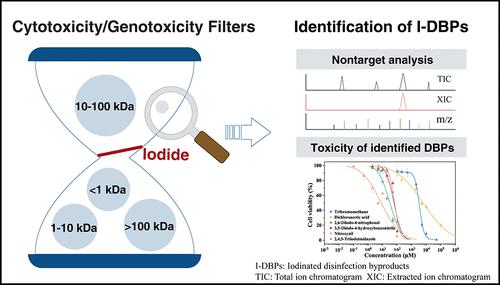高分子量有机物作为氯胺化过程中有毒碘消毒副产物的前体
IF 11.3
1区 环境科学与生态学
Q1 ENGINEERING, ENVIRONMENTAL
引用次数: 0
摘要
碘化DBPs (I-DBPs)比受管制的氯化和/或溴化DBPs毒性更大,是安全饮用水供应方面的一个主要挑战。虽然已经确定了800多个dbp,但毒性i - dbp的发生和前体仍然知之甚少。本研究利用超滤膜将两种原始饮用水中的天然有机物按分子量分成不同的基团。1 kDa部分消毒后表现出最高水平的细胞毒性和遗传毒性。然而,在碘化物存在的情况下,10-100 kDa部分的毒性/溶解有机碳值最高。FT-ICR MS分析表明,次碘酸与10-100 kDa组分之间具有较高的反应活性,并且在10-100 kDa组分氯胺化过程中,由芳香分子和不饱和分子向更饱和的氧化分子转变。在非目标分析的基础上,利用轨道阱质谱法鉴定了10-100 kDa组分氯胺化过程中4个峰强度较高的I-DBPs,并用化学标准物:4-羟基-3-碘-5-硝基苯腈、2,4,5-三碘咪唑、3,5-二碘-4-羟基苯腈和2,6-二碘-4-硝基苯酚进行了鉴定。前两种是在饮用水中发现的。成品水和自来水中四种DBPs的浓度范围为<;LOD至20.7 ng/L。此外,这四种I-DBPs的毒性比受管制的三溴甲烷和二氯乙酸高2-3个数量级。总的来说,我们的研究强调了10-100 kDa的高分子量有机物是氯胺化过程中毒性I-DBPs的主要前体基团,并为这一重要类别的DBPs的关键研究挑战提供了见解。本文章由计算机程序翻译,如有差异,请以英文原文为准。

High Molecular-Weight Organics as Precursors for Toxic Iodinated Disinfection Byproducts during Chloramination
Iodinated DBPs (I-DBPs), many more toxic than regulated chlorinated and/or brominated DBPs, are a major challenge in the supply of safe drinking water. While over 800 DBPs have been identified, the occurrence and precursors of toxic I-DBPs remain poorly understood. Herein, natural organic matter from two raw drinking waters was fractionated using ultrafiltration membranes into different groups based on molecular weight (MW). The <1 kDa fraction exhibited the highest levels of cytotoxicity and genotoxicity after disinfection. However, in the presence of iodide, the 10–100 kDa fraction had the highest toxicity/dissolved organic carbon values. FT-ICR MS analysis showed high reactivity between hypoiodous acid and the 10–100 kDa fraction, and a shift from aromatic and unsaturated molecules to more saturated and oxidized molecules during chloramination of 10–100 kDa fraction. Based on nontarget analysis using orbitrap MS, four I-DBPs with high peak intensities during chloramination of 10–100 kDa fraction were identified and then confirmed using chemical standards: 4-hydroxy-3-iodo-5-nitrobenzonitrile, 2,4,5-triiodoimidazole, 3,5-diiodo-4-hydroxybenzonitrile, and 2,6-diiodo-4-nitrophenol. The first two have been first identified in drinking water. The concentrations of the four DBPs ranged from <LOD to 20.7 ng/L in the finished waters and tap waters. Moreover, the four I-DBPs were 2–3 orders of magnitude more toxic than regulated tribromomethane and dichloroacetic acid. Overall, our study highlights the 10–100 kDa fraction of high molecular weight organics as the primary precursor group for toxic I-DBPs during chloramination and provides insights into key research challenges for this important category of DBPs.
求助全文
通过发布文献求助,成功后即可免费获取论文全文。
去求助
来源期刊

环境科学与技术
环境科学-工程:环境
CiteScore
17.50
自引率
9.60%
发文量
12359
审稿时长
2.8 months
期刊介绍:
Environmental Science & Technology (ES&T) is a co-sponsored academic and technical magazine by the Hubei Provincial Environmental Protection Bureau and the Hubei Provincial Academy of Environmental Sciences.
Environmental Science & Technology (ES&T) holds the status of Chinese core journals, scientific papers source journals of China, Chinese Science Citation Database source journals, and Chinese Academic Journal Comprehensive Evaluation Database source journals. This publication focuses on the academic field of environmental protection, featuring articles related to environmental protection and technical advancements.
 求助内容:
求助内容: 应助结果提醒方式:
应助结果提醒方式:


